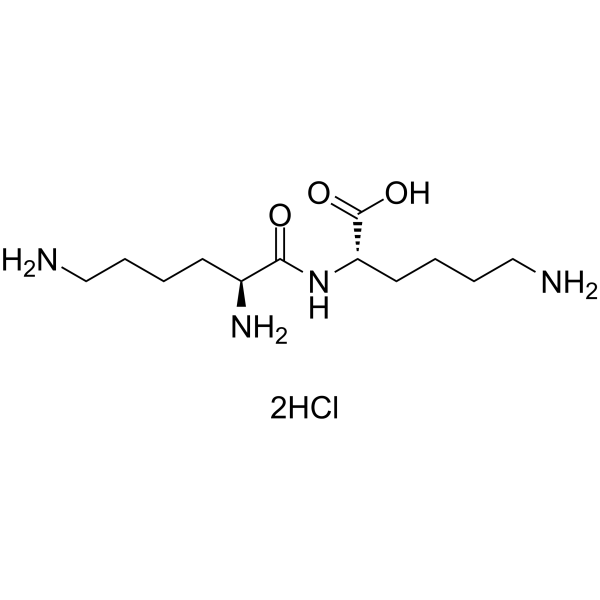h-lys-lys-oh 2hcl

h-lys-lys-oh 2hcl structure
|
Common Name | h-lys-lys-oh 2hcl | ||
|---|---|---|---|---|
| CAS Number | 52123-30-5 | Molecular Weight | 347.28200 | |
| Density | N/A | Boiling Point | N/A | |
| Molecular Formula | C12H28Cl2N4O3 | Melting Point | N/A | |
| MSDS | Chinese USA | Flash Point | N/A | |
| Symbol |

GHS07 |
Signal Word | Warning | |
|
Canine zona pellucida glycoprotein-3: up-scaled production, immunization strategy and its outcome on fertility.
Vaccine 33(1) , 133-40, (2014) Zona pellucida (ZP) glycoproteins based contraceptive vaccines have been proposed for the management of wildlife population. In the present study, a fusion protein encompassing promiscuous T cell epitope of tetanus toxoid [TT; amino acid (aa) residues 830-844... |
|
|
A single binding site for dilysine retrieval motifs and p23 within the gamma subunit of coatomer.
Proc. Natl. Acad. Sci. U. S. A. 95(20) , 11649-54, (1998) Coatomer, the major component of the coat of COPI transport vesicles, binds both to the dilysine motif of resident membrane proteins of the endoplasmic reticulum and to the cytoplasmic domain of p23, a major type I membrane protein of COPI vesicles. Using a p... |
|
|
Intracellular targeting signals contribute to localization of coronavirus spike proteins near the virus assembly site.
J. Virol. 78(11) , 5913-22, (2004) Coronavirus budding at the endoplasmic reticulum-Golgi intermediate compartment (ERGIC) requires accumulation of the viral envelope proteins at this point in the secretory pathway. Here we demonstrate that the spike (S) protein from the group 3 coronavirus in... |
|
|
Targeted gap junction protein constructs reveal connexin-specific differences in oligomerization.
J. Biol. Chem. 277(23) , 20911-8, (2002) To define further the mechanisms of gap junction protein (connexin (Cx)) oligomerization without pharmacologic disruption, we have examined the transport and assembly of connexin constructs containing C-terminal di-lysine-based endoplasmic reticulum (ER) (HKK... |
|
|
Peptide binding in OppA, the crystal structures of the periplasmic oligopeptide binding protein in the unliganded form and in complex with lysyllysine.
Biochemistry 36(32) , 9747-58, (1997) The periplasmic oligopeptide binding protein, OppA, acts as the initial receptor for the uptake of peptides by the oligopeptide permease (Opp) in Gram-negative bacteria. Opp will handle peptides between two and five amino acid residues regardless of their seq... |
|
|
Endoplasmic reticulum retention of the large splice variant of the UDP-galactose transporter is caused by a dilysine motif.
Glycobiology 15(10) , 905-11, (2005) Nucleotide-sugar transporters supply mainly the Golgi glycosyltransferases with substrates. Some glycosyltransferases in the endoplasmic reticulum (ER), however, also use activated sugars. Recent studies have demonstrated that UDP-galactose (UDP-Gal) is the s... |
|
|
Toxoplasma gondii dense granule protein 3 (GRA3) is a type I transmembrane protein that possesses a cytoplasmic dilysine (KKXX) endoplasmic reticulum (ER) retrieval motif.
Parasitology 131(Pt 2) , 169-79, (2005) Studies using antibodies to immunolocalize the Toxoplasma gondii dense granule protein GRA3, have shown that this protein associates strongly with the parasitophorous vacuole membrane (PVM). However, as there was no predicted membrane-spanning domain this hig... |
|
|
An intact dilysine-like motif in the carboxyl terminus of MAL is required for normal apical transport of the influenza virus hemagglutinin cargo protein in epithelial Madin-Darby canine kidney cells.
Mol. Biol. Cell 12(6) , 1869-83, (2001) The MAL proteolipid, a component of the integral protein sorting machinery, has been demonstrated as being necessary for normal apical transport of the influenza virus hemagglutinin (HA) and the overall apical membrane proteins in Madin-Darby canine kidney (M... |
|
|
The stop transfer sequence of the human UDP-glucuronosyltransferase 1A determines localization to the endoplasmic reticulum by both static retention and retrieval mechanisms.
FEBS J. 272(4) , 1063-71, (2005) Human UDP-glucuronosyltransferase 1A (UGT1A) isoforms are endoplasmic reticulum (ER)-resident type I membrane proteins responsible for the detoxification of a broad range of toxic phenolic compounds. These proteins contain a C-terminal stop transfer sequence ... |
|
|
Mapping the binding areas of human C-reactive protein for phosphorylcholine and polycationic compounds. Relationship between the two types of binding sites.
J. Biol. Chem. 277(1) , 225-32, (2002) We developed a fluorescence-based assay method for determining ligand binding activities of C-reactive protein (CRP) in solution. Using this method, we compared the phosphorylcholine (PC)- and polycation-based binding activities of human CRP. The PC-based bin... |